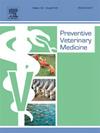Patterns and factors influencing antibiotic use among poultry farmers in Thai Nguyen province, Vietnam
IF 2.4
2区 农林科学
Q1 VETERINARY SCIENCES
引用次数: 0
Abstract
Understanding the patterns and drivers of antibiotic use in poultry production is essential for designing effective stewardship and farm management strategies. We analysed antibiotic use patterns, farm management practices, and factors influencing use among 398 semi-intensive poultry farms in Thai Nguyen province, Vietnam. Data on antibiotic use and mortality during the last production cycle, and biosecurity measures were collected using a structured questionnaire and analyzed descriptively and statistically. Antibiotic use was reported by 77 % of intensive farms, 70 % medium-scale farms and 33 % small-scale farms, with 76 %, 59 % and 54 % of these respectively, indicating use for therapeutic purposes. Doxycycline and Amoxicillin were the most used antibiotics on intensive and medium-scale farms, while tylosin and amoxicillin were common on small-scale farms. Biosecurity levels were low across all farm types, although intensive farms reported higher implementation. Farmers prioritised external biosecurity measures, particularly those related to infrastructure, biological vectors, and feed and water management. Mortality rates were low, averaging 1.5 % on intensive farms, 3 % on medium-scale farms, and 1.7 % on small-scale farms. In small-scale farms, antibiotic use was significantly associated with the presence of other poultry types (OR: 3.3), farmers’ perception of antibiotic effectiveness (OR: 2.3), having a fence (OR=3.3) and high morbidity (OR=1.1). Storing feed on elevated floors reduced likelihood of use (OR=0.2). On medium-scale farms, high morbidity (OR=1.3) and storing feed in a separate room (OR=3.5) were linked to increased use. Among intensive farms, high morbidity was associated antibiotic use (OR=10.7). These findings highlight the need for targeted interventions to strengthen biosecurity, enforce regulations, and promote responsible antibiotic use in Vietnam's poultry sector.
影响越南太原省家禽养殖户抗生素使用的模式和因素
了解家禽生产中抗生素使用的模式和驱动因素对于设计有效的管理和农场管理策略至关重要。我们分析了越南泰阮省398个半集约化家禽养殖场的抗生素使用模式、农场管理实践和影响抗生素使用的因素。采用结构化问卷收集上一个生产周期的抗生素使用和死亡率数据,并对生物安全措施进行描述性和统计学分析。有77% %的集约化养殖场、70% %的中型养殖场和33% %的小型养殖场报告使用抗生素,其中76 %、59 %和54 %的养殖场报告使用抗生素用于治疗目的。多西环素和阿莫西林是集约化和中等规模养殖场使用最多的抗生素,而泰洛辛和阿莫西林在小规模养殖场使用最多。所有农场类型的生物安全水平都很低,尽管集约化农场的实施情况较高。农民优先考虑外部生物安全措施,特别是与基础设施、生物媒介以及饲料和水管理有关的措施。死亡率很低,集约化农场平均为1.5 %,中等规模农场为3 %,小规模农场为1.7 %。在小规模养殖场,抗生素的使用与其他家禽类型的存在(OR: 3.3)、农民对抗生素有效性的看法(OR: 2.3)、围栏(OR=3.3)和高发病率(OR=1.1)显著相关。将饲料储存在高架地板上降低了使用的可能性(OR=0.2)。在中等规模养殖场,高发病率(OR=1.3)和在单独房间储存饲料(OR=3.5)与使用增加有关。在集约化农场中,高发病率与抗生素使用有关(OR=10.7)。这些发现突出表明,需要采取有针对性的干预措施,以加强越南家禽业的生物安全、执行法规和促进负责任地使用抗生素。
本文章由计算机程序翻译,如有差异,请以英文原文为准。
求助全文
约1分钟内获得全文
求助全文
来源期刊

Preventive veterinary medicine
农林科学-兽医学
CiteScore
5.60
自引率
7.70%
发文量
184
审稿时长
3 months
期刊介绍:
Preventive Veterinary Medicine is one of the leading international resources for scientific reports on animal health programs and preventive veterinary medicine. The journal follows the guidelines for standardizing and strengthening the reporting of biomedical research which are available from the CONSORT, MOOSE, PRISMA, REFLECT, STARD, and STROBE statements. The journal focuses on:
Epidemiology of health events relevant to domestic and wild animals;
Economic impacts of epidemic and endemic animal and zoonotic diseases;
Latest methods and approaches in veterinary epidemiology;
Disease and infection control or eradication measures;
The "One Health" concept and the relationships between veterinary medicine, human health, animal-production systems, and the environment;
Development of new techniques in surveillance systems and diagnosis;
Evaluation and control of diseases in animal populations.
 求助内容:
求助内容: 应助结果提醒方式:
应助结果提醒方式:


